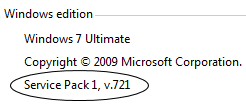Windows 7 Service Pack 1 Changes
Any program’s SP1 will be the easiest to install simply because you don’t have to worry about accumulating all the previous service packs as you do with SP2s and SP3s.
- Windows SP1 Features
- Actual Install of Windows 7 SP1
- RemoteFX in Windows 7 SP1
- Service Pack Urban Myths
- Windows 8 "Blue" SP
- Review of Windows Server 2008 SP1
♦
Windows 7 SP1 Features
We expect Windows service packs to contain hot-fixes and security updates, but what’s almost unprecedented with Windows 7’s SP1 is that Microsoft introduce so few new features. Actually, the fact that SP1 is so boring is a compliment to Microsoft testing the original Windows 7 RTM so thoroughly. My cynical friend Barking Eddie turns this observation on its head and says that Windows 7 should have been called Vista SP4, and this should be Vista SP5.
Once you find the Windows 7 SP1 download site, one 32-bit (x86) service pack will cover all desktop / laptop editions of Windows 7, but not embedded operating systems. Naturally, there is a separate SP1 file for 64-bit operating systems, which is designed for both Windows 7 AND Server 2008 R2.
Actual Install of Windows 7 SP1
Applying Windows 7 service pack 1 was smooth and straightforward, the hardest part was finding the download in amongst the myriad of updates on Microsoft’s site.
- Naturally, log on to your computer as an administrator best close any open programs.
- A good idea is to check that you have a recent backup; also update any device drivers from the manufacturers’ sites.
- For laptops, try and connect to an AC electrical outlet for the duration of the install rather than rely on the battery.
- Update any device drivers as necessary. You can do this by using Windows Update in Control Panel, or by going to the device manufacturer’s website.
- Beware, most antivirus software prevents SP1 from installing, thus take the time to discover how to disable your antivirus software while you install Windows 7 SP1.

- Make sure you have enough free disk space to install SP1. The estimated disk space required to install SP1 from the Microsoft website or from an SP1 installation DVD is:
32-bit (x86-based): 1800 MB
64-bit (x64-based): 3300 MB - If there are language packs installed on your computer, you will need additional disk.
- Check that your build is now Windows 7 SP1 7601 and not 7600.
 Guy Recommends You Try SolarWinds Patch Manager (SPM)
Guy Recommends You Try SolarWinds Patch Manager (SPM)
With SPM you can push out patches, which companies such as Mozilla Firefox or Adobe Acrobat provide. The point is that because WSUS does not do this for non-Microsoft software updates, you need a good add-on to take care of this task. With the Patch Manager you can even create your own packages to apply to your servers or clients.
Download your free trial of SolarWinds Patch Manager
RemoteFX Changes in Windows 7 SP1
No review of Windows 7 SP1 would be complete without a mention of RemoteFX. If you have used Remote Desktop then you will have been disappointed with the graphics experience compared with running Windows 7 locally. SP1 introduces an updated client to supply RDP (Remote Desktop Protocol) connections with RemoteFX.
With Windows 7 SP1, RemoteFX improves the Remote Desktop experience by supporting Windows Aero, full-motion video, and 3D graphics. To reap these benefits make sure the Windows 2008 Server has a DirectX 10.0 graphics card to support the Windows 7 SP1 guest operating system.
Incidentally, this technology has undergone more re-naming than any other Windows component, what used to be called Terminal Services is now Session Virtualization.
Dynamic Memory Changes in Windows 7 SP1
According to Microsoft, dynamic memory "allows customers to achieve increased density when they’re consolidating physical servers into a virtual realm, providing them with predictable performance and linear scalability." Translated: IT administrators can dice up the physical memory on a machine, like a server, and dole it out to many different virtual machines on the fly.
See SolarWinds Patch Manager »
Summary Windows 7 SP1 Changes
Actually, your Windows 7 will probably already have 95% of the fixes and updates supplied by SP1. Nevertheless, when you are rebuilding a machine it’s handy to have them all in one file.
Although there is every indication that Windows 7 SP1 (Build 7601) will be trouble-free, best practice recommends that you test on one machine before applying to a whole network. In addition, take the opportunity to check both Windows Update settings and your Restore points.
The highlight of my review of Windows 7 SP1 is RemoteFX. What this does is give Remote Desktop the graphics performance of a local machine.
Recommended: Solarwinds’ Permissions Analyzer – Free Active Directory Tool
I like thePermissions Analyzer because it enables me to see WHO has permissions to do WHAT at a glance. When you launch this tool it analyzes a users effective NTFS permissions for a specific file or folder, and takes into account network share access, then displays the results in a nifty desktop dashboard!
Think of all the frustration that this free SolarWinds utility saves when you are troubleshooting authorization problems for user’s access to a resource. Give this permissions monitor a try – it’s free!
Download SolarWinds’ Free Permissions Analyser – Active Directory Tool
Service Pack’s Personality
Each service pack has its own personality. Just as the children, and grandchildren in any family show different traits, so Microsoft’s service packs vary in their characteristics. Any program’s SP1 will be the most docile and easiest to install simply because you don’t have to worry about accumulating all the previous SPs as you do with SP2s and SP3s.
First-born children are often the favorites, and the birth of any SP1 is traditionally the trigger for businesses to order that particular operating from their system supplier. However, don’t be premature installing a beta version of Windows SP1, my advice is to wait for delivery of the final RTM version.
For me a service pack also provides peace of mind. I don’t often check my Windows Update History, but when I did, I was shocked to see that some updates failed. To be fair, it seemed that the Automatic Update Service tried again and invariably succeed in the next update cycle. My abiding thought is that SP1 will ‘roll-up’ these updates, and thus ensure that I have not missed any.
See Also SolarWinds Free WSUS Tool »
Service Pack Urban Myths
One of the most enduring myths is that applying SP1 to an evaluation copy will break the time-lock and thus give you a fully functioning version of Windows 7. Not true. This myth started in the days of Windows NT4, and even back then I did not believe that a service pack could transform an evaluation copy into a fully functioning version.
There is also the reverse of the above myth, the theory that SP1 will make pirate versions of Windows 7 unusable. There has long been a threat that Microsoft would add code to service packs that detect pirate product keys, and then cause those systems to lock until that machine gets a genuine licence.
Back with XP Microsoft flirted with such ideas to tackle software piracy, for example they introduced the Reduced Functionality Mode (RFM) and Non-Genuine State (NGS). The problem is that this also irritated people with genuine licences when things went wrong, for example internet connection problems when authenticating genuine product keys could lead to NGS. However, there is no indication of any such anti-piracy tricks in Windows 7 SP1. See more on service packs.
If you like this page then please share it with your friends


